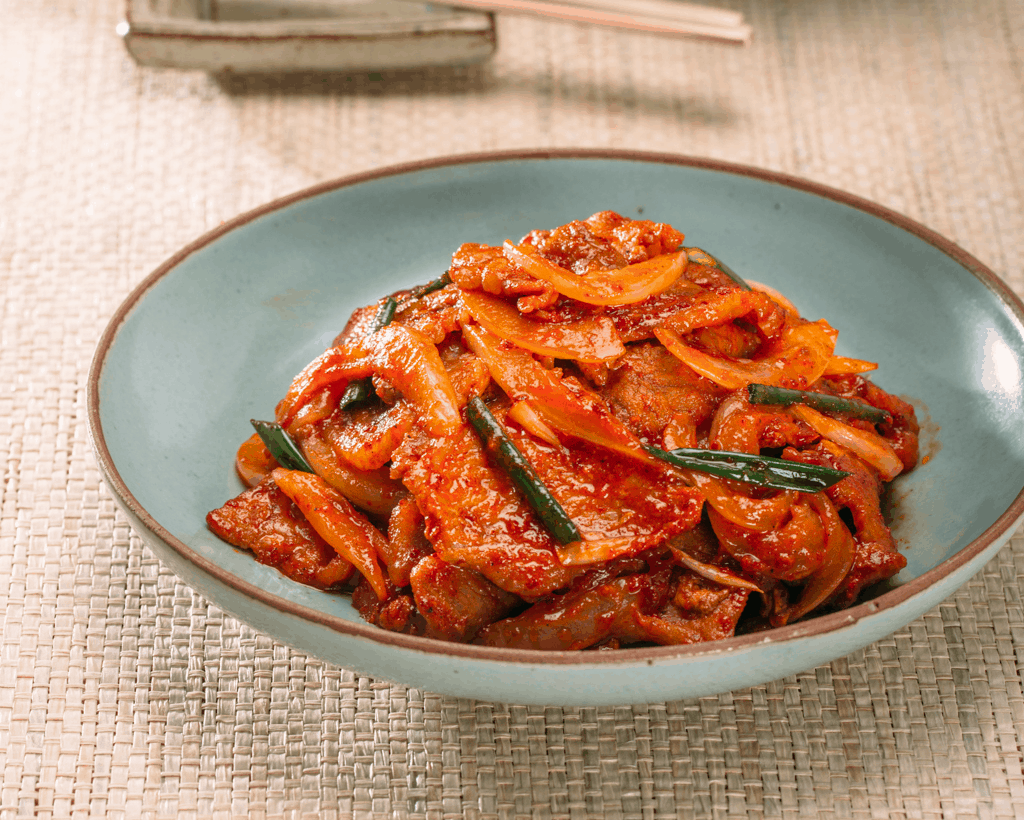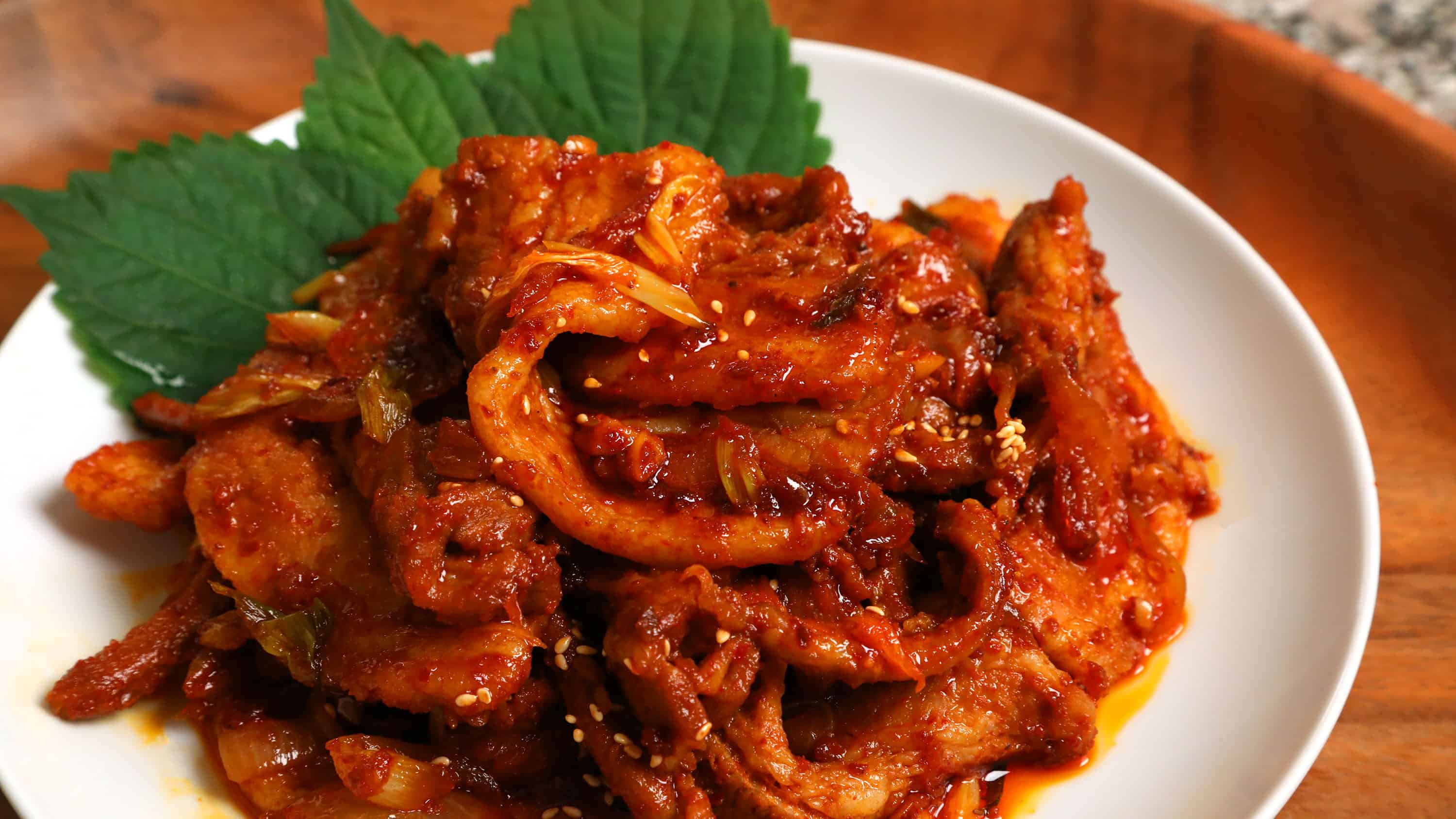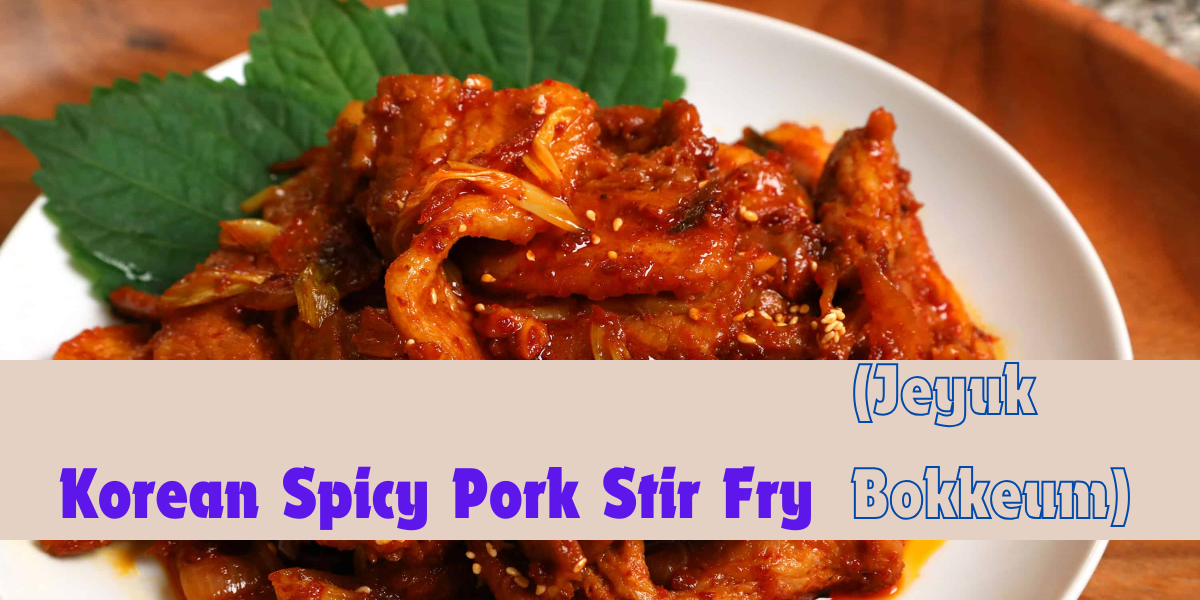Introduction
Korean cuisine has a rich and diverse range of dishes that showcase its unique flavors, ingredients, and cooking techniques. One standout dish is Jeyuk Bokkeum, also known as Korean Spicy Pork Stir Fry. This flavorful and aromatic dish is a staple in Korean households and restaurants, celebrated for its perfect balance of sweet, spicy, and savory notes. The combination of tender pork, vibrant vegetables, and a rich, spicy sauce makes Jeyuk Bokkeum a delightful culinary experience.
Historical Background
Jeyuk Bokkeum has deep roots in Korean culinary traditions. The dish is believed to have originated during the Joseon Dynasty (1392-1897), a period marked by significant developments in Korean cuisine. The introduction of chili peppers from the Americas in the late 16th century played a crucial role in shaping the spicy flavor profile that characterizes Jeyuk Bokkeum. Over the centuries, this dish has evolved, incorporating regional variations and family recipes, but its core ingredients and preparation methods have remained consistent.
Korean Spicy Pork Stir Fry (Jeyuk Bokkeum)
Korean Spicy Pork Stir Fry, or Jeyuk Bokkeum, offers a variety of health benefits due to its balanced combination of lean protein, vegetables, and spices. Let’s delve into the specific components that contribute to its nutritional value:
Lean Protein from Pork
- High-Quality Protein: Pork is a rich source of high-quality protein, essential for muscle growth, repair, and overall body function.
- Vitamins and Minerals: Pork provides important vitamins and minerals, including B vitamins (B6 and B12), zinc, iron, and selenium. These nutrients support energy metabolism, immune function, and cognitive health.
- Leaner Cuts: Using leaner cuts of pork, such as pork loin or tenderloin, can reduce the overall fat content while still providing beneficial nutrients.

Vegetables
- Nutrient-Dense: Vegetables like bell peppers, carrots, onions, and green onions are packed with essential vitamins, minerals, and antioxidants. These nutrients promote good health, support immune function, and help protect against chronic diseases.
- Fiber: The vegetables in Jeyuk Bokkeum add dietary fiber, which aids in digestion, helps maintain healthy blood sugar levels, and supports heart health.
- Low-Calorie: Vegetables are naturally low in calories, making the dish more filling without adding excessive calories.
Fermented Ingredients
- Gochujang and Gochugaru: These fermented chili products are rich in capsaicin, which has been linked to various health benefits, including boosting metabolism, reducing inflammation, and providing antioxidants. Fermented foods like gochujang also contribute probiotics, which support gut health.
Healthy Cooking Methods
- Stir-Frying: Stir-frying is a quick cooking method that helps retain the nutrients in vegetables and minimizes the use of oil, making it a healthier cooking option.
- Controlled Sodium Levels: While Jeyuk Bokkeum can be high in sodium due to soy sauce and gochujang, using low-sodium alternatives and adjusting the amount of added salt can make the dish healthier.
Balanced Meal
- Whole Grains: Serving Jeyuk Bokkeum with brown rice or mixed grain rice (japgokbap) instead of white rice can increase fiber intake and provide a slower-releasing source of energy.
- Lettuce Wraps: Using lettuce wraps to serve Jeyuk Bokkeum adds additional fiber, vitamins, and a refreshing crunch, making the meal lighter and more nutritious.
Tips for Making a Healthier Jeyuk Bokkeum
- Choose Lean Cuts of Pork: Opt for leaner cuts like pork loin or tenderloin to reduce fat content.
- Increase Vegetable Content: Add a variety of colorful vegetables to boost the nutrient profile and fiber content.
- Use Less Oil: Use minimal oil for stir-frying and consider using healthier oils like olive oil or sesame oil.
- Control Sodium Intake: Use low-sodium soy sauce and gochujang, and adjust the amount of added salt.
- Serve with Whole Grains: Pair the dish with brown rice or mixed grain rice for added fiber and nutrients.
- Portion Control: Enjoy Jeyuk Bokkeum as part of a balanced meal, keeping portion sizes in check to avoid overeating.
By making these adjustments and focusing on the quality and balance of ingredients, Jeyuk Bokkeum can be a nutritious and delicious part of a healthy diet.
Key Ingredients
The key ingredients of Jeyuk Bokkeum include pork, gochujang (Korean red chili paste), gochugaru (Korean red chili flakes), soy sauce, garlic, ginger, onions, and a variety of vegetables such as bell peppers, carrots, and green onions. Each ingredient contributes to the dish’s complex flavor profile:
- Pork: Typically, pork belly or shoulder is used for its tender and flavorful qualities.
- Gochujang: This fermented chili paste adds depth, sweetness, and a spicy kick to the dish.
- Gochugaru: Korean chili flakes enhance the spiciness and add a vibrant red color.
- Soy Sauce: Provides a salty, umami flavor that balances the sweetness of gochujang.
- Garlic and Ginger: Essential aromatics that add a pungent and slightly spicy undertone.
- Vegetables: Bell peppers, carrots, and onions add texture, color, and natural sweetness.
Preparation and Cooking Techniques
Preparing Jeyuk Bokkeum involves marinating the pork, stir-frying it with vegetables, and combining it with a flavorful sauce. Here’s a step-by-step guide:
- Marinating the Pork:
- Thinly slice the pork belly or shoulder.
- In a bowl, combine gochujang, gochugaru, soy sauce, minced garlic, grated ginger, sugar, and a splash of sesame oil.
- Add the pork slices to the marinade, ensuring they are evenly coated. Let it marinate for at least 30 minutes to allow the flavors to penetrate the meat.
- Stir-Frying:
- Heat a large pan or wok over medium-high heat and add a small amount of vegetable oil.
- Add the marinated pork and stir-fry until it is almost cooked through.
- Add sliced onions, bell peppers, and carrots. Continue stir-frying until the vegetables are tender but still crisp.
- Adjust the seasoning with additional soy sauce or gochujang if needed.
- Final Touches:
- Garnish with sliced green onions and toasted sesame seeds.
- Serve hot with steamed rice or wrapped in lettuce leaves for a complete meal.

Nutritional Benefits
Jeyuk Bokkeum is not only delicious but also packed with nutritional benefits. Pork provides high-quality protein, essential vitamins (such as B12 and B6), and minerals (such as zinc and iron). The vegetables add dietary fiber, vitamins, and antioxidants, while the fermented ingredients like gochujang contribute beneficial probiotics. However, due to its high sodium content, it is advisable to consume Jeyuk Bokkeum in moderation, especially for individuals with hypertension.
Cultural Significance
In Korean culture, Jeyuk Bokkeum holds a special place as a comfort food and a popular dish for family gatherings and celebrations. It is often enjoyed with a variety of side dishes (banchan) and paired with traditional Korean alcoholic beverages like soju or makgeolli. The communal aspect of sharing a meal of Jeyuk Bokkeum fosters a sense of togetherness and reflects the importance of food in Korean social and cultural life.
Variations and Regional Differences
While the basic recipe for Jeyuk Bokkeum is widely recognized, there are numerous regional variations and adaptations. For instance:
- Jeolla Province: Known for its bold flavors, Jeyuk Bokkeum from this region may include additional spices and herbs.
- Gyeongsang Province: This version might feature a slightly sweeter marinade with the addition of fruits like apples or pears.
- Vegetarian Version: For those who prefer a meatless option, tofu or mushrooms can be used as a substitute for pork, retaining the dish’s signature flavors.
Pairing and Serving Suggestions
Jeyuk Bokkeum pairs wonderfully with a range of side dishes and beverages. Here are some suggestions:
- Banchan (Side Dishes): Kimchi, pickled radishes, and seasoned spinach complement the spicy flavors of Jeyuk Bokkeum.
- Rice: Steamed white rice or Korean mixed grain rice (japgokbap) helps balance the spiciness.
- Lettuce Wraps: Wrapping the stir-fried pork in lettuce leaves with a dab of ssamjang (Korean dipping sauce) adds freshness and crunch.
- Beverages: Soju, makgeolli, or even a light, crisp beer can enhance the dining experience.
Conclusion
Jeyuk Bokkeum, with its rich history, flavorful ingredients, and cultural significance, is a quintessential dish in Korean cuisine. Its vibrant taste and versatility make it a favorite among both Koreans and international food enthusiasts. Whether enjoyed as a comforting home-cooked meal or a highlight at a festive gathering, Jeyuk Bokkeum embodies the essence of Korean culinary tradition and the joy of sharing delicious food.
By exploring and appreciating dishes like Jeyuk Bokkeum, we gain a deeper understanding of Korea’s culinary heritage and the artistry involved in creating such memorable and satisfying meals.

Korean Spicy Pork Stir Fry (Jeyuk Bokkeum)
Equipment
-
Blow Torch
Ingredients
- 350 grams Pork Shoulder Butt Sliced thinly
- 200 grams Cabbage Sliced julienne
- 100 grams Onion Sliced julienne
- 25 grams Carrots Sliced julienne
- 3 stalks Scallions Chop white part, slice to 3-in pieces the green part
- 1 pc Jalapeno Optional
- 1/2 tbsp Garlic
- 2 tbsp Korean Red Pepper Paste or Gochujang
- 1 tbsp Red Pepper Flakes
- 1/2 tbsp Red Pepper Powder
- 1 tbsp Soy Sauce
- 1 tbsp Sesame Oil
- 1 tbsp Sugar
- 1 tbsp Corn Syrup
- Sesame Seeds
- Black Pepper To taste
- Vegetable or Canola Oil For sauteing
Instructions
-
Prepare the pork and the vegetables.
-
Combine gochujang, pepper flakes, pepper powder, soy sauce, sesame oil, sugar, corn syrup, sesame seeds, and black pepper. Mix thoroughly and set aside.
-
In high heat, saute garlic and pork with a bit of oil.
-
When the pork is 70% done, mix in the vegetables and mix thoroughly.
-
Add the sauce and mix thoroughly.
-
Stir fry for 3-4 minutes more or until the vegetables are cooked but still have crunch. Do not overcook.
-
To give it a grilled taste, torch the spicy pork until there are several burnt marks.
-
Plate and top with some more sesame seeds.
-
Serve with rice or noodles and enjoy!
FAQs
1. What is Jeyuk Bokkeum?
Answer: Jeyuk Bokkeum, also known as Korean Spicy Pork Stir Fry, is a popular Korean dish made with thinly sliced pork marinated in a spicy sauce. It typically includes vegetables like bell peppers, onions, and carrots, and is stir-fried until the pork is tender and the vegetables are cooked but still crisp.
2. What type of pork is best for Jeyuk Bokkeum?
Answer: The most commonly used cuts for Jeyuk Bokkeum are pork belly or shoulder due to their tenderness and flavor. However, leaner cuts like pork loin or tenderloin can also be used for a healthier option.
3. How spicy is Jeyuk Bokkeum?
Answer: The spiciness of Jeyuk Bokkeum can vary depending on the amount of gochujang (Korean red chili paste) and gochugaru (Korean red chili flakes) used. It is typically moderately spicy, but you can adjust the heat level to your preference by adding more or less of these ingredients.
4. Can I make Jeyuk Bokkeum less spicy?
Answer: Yes, you can reduce the spiciness by using less gochujang and gochugaru. You can also add a bit of sugar or honey to balance the heat and add sweetness to the dish.
5. Is Jeyuk Bokkeum healthy?
Answer: Jeyuk Bokkeum can be a healthy dish when made with lean cuts of pork and plenty of vegetables. It is high in protein, vitamins, and minerals. However, it can be high in sodium due to ingredients like soy sauce and gochujang, so it’s best to consume it in moderation and use low-sodium alternatives if possible.
6. What are some common vegetables used in Jeyuk Bokkeum?
Answer: Common vegetables used in Jeyuk Bokkeum include bell peppers, onions, carrots, and green onions. You can also add other vegetables like zucchini, mushrooms, or cabbage for added variety and nutrition.
7. How do I serve Jeyuk Bokkeum?
Answer: Jeyuk Bokkeum is traditionally served with steamed rice and a variety of side dishes (banchan). It can also be enjoyed wrapped in lettuce leaves with a dab of ssamjang (Korean dipping sauce) for added freshness and texture.
8. Can I make Jeyuk Bokkeum ahead of time?
Answer: Yes, you can prepare the marinade and marinate the pork ahead of time. The marinated pork can be stored in the refrigerator for up to 24 hours before cooking. The dish is best enjoyed fresh, but leftovers can be stored in the refrigerator for a couple of days and reheated.
9. Can Jeyuk Bokkeum be made vegetarian?
Answer: Yes, you can make a vegetarian version of Jeyuk Bokkeum by substituting the pork with tofu, tempeh, or mushrooms. The marinade and cooking method remain the same, allowing the vegetarian ingredients to absorb the flavors of the sauce.
10. What is the difference between Jeyuk Bokkeum and Bulgogi?
Answer: Both Jeyuk Bokkeum and Bulgogi are popular Korean stir-fry dishes, but they have distinct differences. Jeyuk Bokkeum is made with spicy marinated pork, while Bulgogi is typically made with beef marinated in a sweet and savory sauce. The flavor profiles and heat levels of the two dishes are different, with Jeyuk Bokkeum being spicier due to the use of gochujang and gochugaru.
11. Can I freeze Jeyuk Bokkeum?
Answer: It’s not recommended to freeze Jeyuk Bokkeum once cooked, as the texture of the vegetables may become mushy upon thawing and reheating. However, you can freeze the marinated pork before cooking. When ready to cook, simply thaw the pork and proceed with the stir-frying process.
By addressing these frequently asked questions, you can better understand and enjoy the delicious and nutritious qualities of Jeyuk Bokkeum.

